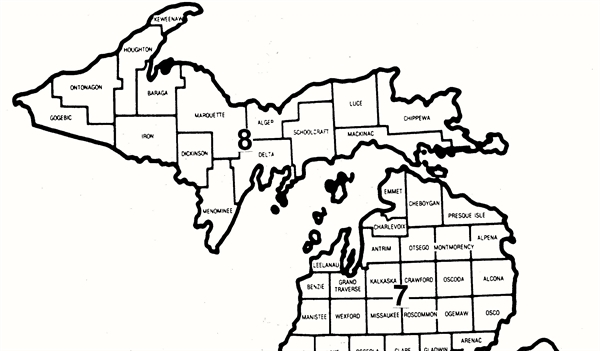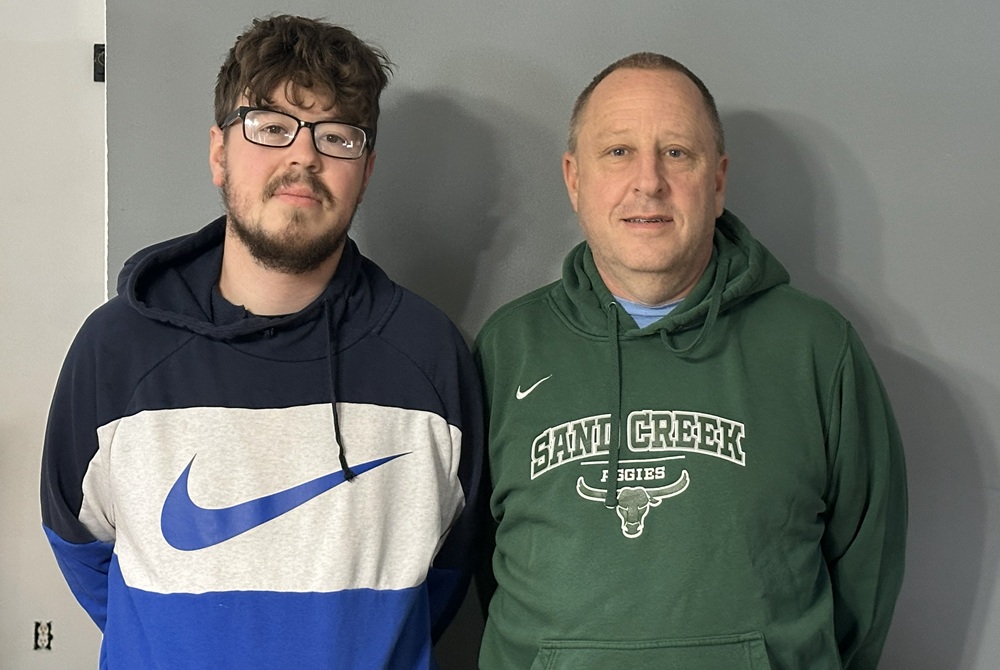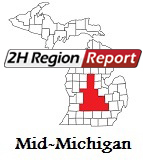
And the MHSAA Survey Says ...
April 2, 2015
By Rob Kaminski
MHSAA benchmarks editor
A survey of MHSAA member schools was conducted in the fall of 2014 aimed to determine opinions for and against a myriad of out-of-season coaching/contact period topics within the school year.
Below are some of the summaries drawn from that survey, plus a map of zones referred to in a number of points.
Survey Summary and Highlights
The larger the school, the higher the percentage of students who are involved in organized non-school sports.
The Detroit metro area (Zone 3) has the highest percentage of respondents in each of two groups in which the highest percentage of students are involved in organized non-school sports ... the 60 to 80% and 40 to 60% groups. The Grand Rapids area (Zone 6) ranks second.
The northern Lower Peninsula (Zone 7) and the Upper Peninsula (Zone 8) have the highest percentage of respondents in the group in which the lowest percentage of students are involved in organized non-school sports . . . the 0 to 20% group. This is also true of Zones 1, 2 and 5, although less dramatically.
In the majority of schools, coaches work with students out of season under the three- or four-player rule for a few weeks just before the season. This is generally true regardless of school classification or geographic zone.
In nearly 80% of schools, the frequency of coaches working with students out of season under the three- or four-player rule is one or two days a week.
100% of schools that sponsor basketball hold open gyms for basketball. Two-thirds of volleyball schools hold volleyball open gyms. Half of lacrosse schools hold lacrosse open gyms. Open gyms in baseball, softball and soccer occur in 40 to 45% of responding schools. Open gyms are less common for other sports.
More than half of all schools conduct open gyms for only a few weeks, just before the season begins.
In 85% of schools, the frequency of open gyms is one or two days a week.
The multi-sport athlete is common in schools of every classification, but more common in Class C and D schools than in Class A and B.
The multi-sport athlete is common in schools of every geographical zone, but more common in Zones 1, 2, 4, 7 and 8 than in Zones 3, 5 and 6.
Two-thirds of schools do not ban athletes from out-of-season workouts while in-season in a different school sport. Permitting weightlifting is most common (84%), then three- or four-player workouts (70%), then conditioning (66%) and open gyms (65%), and finally non-school competitions (57%).
Single-sport coaches are more common in smaller schools than larger (perhaps because fewer sports are sponsored in smaller schools).
For one question, schools were asked to rate ideas from 1 (I like the concept) to 6 (I do not like the concept). Average would be 3.5.
More than 60% of schools favor a no-contact period for all out-of-season sports at the start of every other sport’s season. (Support ranges from 55% for Class A schools to 65% for Class D schools and from 56% for Zones 1 and 3 to 71% for Zone 7.)
More than 72% of schools favor (in conjunction with a no-contact period) a defined contact period out of season. Support ranges from 69% for Class B schools to 76% for Class D schools and from 64% in Zone 6 to 88% in Zone 1.
Two-thirds of schools favor setting a limit on the number of contact days for out-of-season coaching. Support ranges from 63% for Class A schools to 72% for Class C schools and from 50% for Zone 2 to 73% for Zone 1.
More than 68% of schools favor setting a limit on the number of contact days in a week. There’s almost no difference based on school class. Support ranges from 58% in Zone 6 to 76% in Zone 5.
Counting days more than players – that is, allowing practice with any number of students for a defined number of days over a period of time – is favored by more than 72% of schools. Support ranges from 69% for Class D to 76% for Class A and from 59% for Zone 5 to 76.5% for Zone 3.
The least support of any idea surveyed was for allowing scrimmage competition (allowing the coach to coach any number of students from that coach’s school in competition against individuals not enrolled in that school).
More than 62% of schools favor a rule that would allow a school coach to coach a non-school team within a defined contact period; that is, a team with students from the coach’s school (and possibly other schools too), but not supported with school funds, administration, insurance, uniforms, etc. Support ranged from 58% for Class C schools to 68% for Class B schools. Support ranged from 54% for Zone 2 to 69% for Zone 6.
This is the most popular proposal (doesn’t preclude others being approved too): 84% of schools favor removing the phrase “under one roof” from Regulation II, Section 11(H) 2 a (see Tuesday's report). Support ranged from 80% for Class D schools to 86% for Class C schools and from 78% in Zone 2 to 89% for Zone 5.
Removing the portion of Interpretation 237 which prohibits setting up rotations that would allow a coach to work with dozens of players who rotate to his/her direct attention in groups of three or four is favored by 69% of schools, but with a distinct large school vs. small school difference of opinion: Class A (80.5% favorable), Class B (72.9%), Class C (61.3%) and Class D (61.7%).

Father & Son Set to Meet for 1st Time Coaching from Opposing Benches
By
Doug Donnelly
Special for MHSAA.com
December 10, 2025
The bantering back and forth is almost complete.
 On Thursday, Mike and Zachary Zyla will finally coach against each other in a varsity girls basketball game.
On Thursday, Mike and Zachary Zyla will finally coach against each other in a varsity girls basketball game.
It’s a game that both coaches circled months ago when Zachary, 26, got his first head coaching job at Britton Deerfield.
“It’s going to be intense,” Zachary said. “I’m sure he will want to win just as badly as I will. Me and our girls have been talking about the game a lot because it’s a game we think we can win. We want to beat Sand Creek.”
Mike Zyla coaches Sand Creek and is Zachary’s dad. He is a longtime coach in cross country and track and added varsity basketball to his resume three years ago. Zachary, who played at Sand Creek, was hired this past offseason to coach the Patriots.
Both schools are in the Tri-County Conference.
“It’s going to be fun,” Mike said. “We’ve been going back and forth about it for a couple of weeks. We’ll see how it goes.”
Basketball is special in the Zyla household.
Zachary’s other brother, Ryan, coaches at a junior college in Minnesota. His sister, Chelsi, played two years of college basketball after graduating from Sand Creek. Their mom, Kirsten, keeps the scorebook for Mike’s games. She is a special education teacher at Britton Deerfield.
“When basketball season rolls around, that’s all we talk about,” Zachary said.
“I guess it’s a little bit in the bloodlines,” Mike said.
After graduating from Sand Creek in 2018, Zachary served in the Navy. He returned home two years ago and served two seasons as his dad’s assistant.
“I just love the game of basketball,” he said. “I’ve been playing since I was probably 2 years old. It’s the thing I’m passionate about. I watch almost every night. If it’s not a live basketball game, I watch clips of old games. I’m just a junkie for basketball.”
Mike said he misses having his son on his bench.
“I miss having him on staff,” Mike said. “He’s really sharp, picking stuff up on the fly. It was nice having him on the sidelines with me. It’s a good opportunity for him, though.”
Please welcome BD’s new varsity girls basketball coach Zach Zyla! Zach comes to BD from Sand Creek where his father Mike is the head girls coach. Zach assisted on the Aggie varsity girls team in the 2024/25 season and is a track assistant coach for the Aggies. Go Patriots! pic.twitter.com/6cpwUw6OW4
— BD Athletics (@athletics_bd) May 2, 2025
Zachary accepted the job in time to have a summer program with BD.
“I’ve always been a big fan of basketball,” he said. “It’s in my blood. I started coaching the Sand Creek hoopsters when I was 16 years old. I knew that’s what I wanted to do. I would say coaching at the varsity level was a goal of mine. It’s always been a dream of mine. I didn’t expect to get a head coaching job so soon. I’d like to get to the next level someday.”
He said he has a few new things for his team to run against his dad.
“He taught me a lot, but our coaching strategies are different,” Zachary said. “I think I’m going to have some things he hasn’t seen yet.”
Sand Creek and BD both lost their season openers Tuesday. Since BD’s game started at 4:30 p.m., Zachary was able to get to Sand Creek to see his dad’s game against Pittsford.
“He was able to scout us,” Mike said.
It’s all in good fun.
“We have a great relationship,” Zachary said. “We bounce ideas off each other all of the time. Even for our first game of the season, we were talking about what we should do, the offenses and defenses. We talk pretty much every day.”
As rare as it is for a father and son to coach against each other, it’s the second time it’s happened in Lenawee County in recent years. Hudson varsity boys basketball coach Jeff Webster coached against his son, Jamison Webster, when Hudson played Tecumseh two seasons ago.
Jamison said it was a great experience, one the Zylas will never forget.
“Coaching and competing against my dad’s teams at Hudson over the last few years has been a great experience,” he said. “We both want to win, being the competitors we are. That being said, the lifelong memories we have made being able to share a sport we both love is what makes it special.”
Zachary said he knows it will be a little different than normal.
“The game’s intensity will be higher than most nights,” he said.
Mike agreed. He doesn’t relish the idea of beating his son, but doesn’t plan on backing down. Since they are both in the TCC, they’ll face off again later this winter.
“We’re both pretty competitive,” he said. “Competitive genes are in the family. I don’t think either one of us will be very happy if we are on the losing side Thursday night.”
 Doug Donnelly has served as a news and sports reporter at the Adrian Daily Telegram and the Monroe News for 30 years, including 10 years as city editor in Monroe. He's written a book on high school basketball in Monroe County and compiles record books for various schools in southeast Michigan. He is now publisher and editor of The Blissfield Advance, a weekly newspaper. E-mail him at [email protected] with story ideas for Jackson, Washtenaw, Hillsdale, Lenawee and Monroe counties.
Doug Donnelly has served as a news and sports reporter at the Adrian Daily Telegram and the Monroe News for 30 years, including 10 years as city editor in Monroe. He's written a book on high school basketball in Monroe County and compiles record books for various schools in southeast Michigan. He is now publisher and editor of The Blissfield Advance, a weekly newspaper. E-mail him at [email protected] with story ideas for Jackson, Washtenaw, Hillsdale, Lenawee and Monroe counties.
PHOTO Britton Deerfield varsity girls basketball coach Zachary Zyla poses for a photo with his father Mike Zyla, right, the varsity girls basketball coach at Sand Creek. (Photo provided by the Zyla family.)

